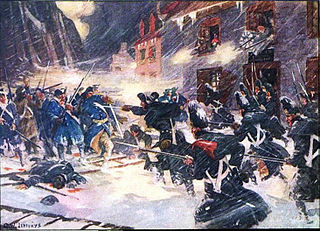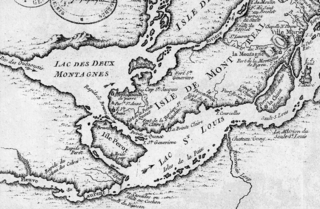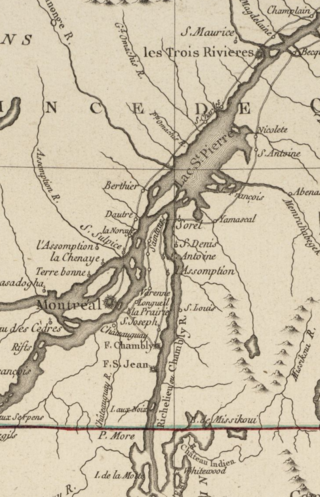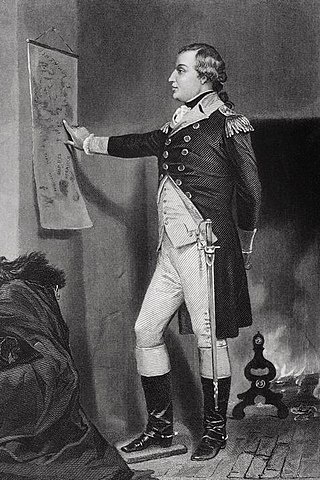
The Invasion of Quebec was the first major military initiative by the newly formed Continental Army during the American Revolutionary War. The objective of the campaign was to seize the Province of Quebec from Great Britain, and persuade French-speaking Canadiens to join the revolution on the side of the Thirteen Colonies. One expedition left Fort Ticonderoga under Richard Montgomery, besieged and captured Fort Saint-Jean, and very nearly captured British General Guy Carleton when taking Montreal. The other expedition, under Benedict Arnold, left Cambridge, Massachusetts, and traveled with great difficulty through the wilderness of Maine to Quebec City. The two forces joined there, but they were defeated at the Battle of Quebec in December 1775.

The Battle of Quebec was fought on December 31, 1775, between American Continental Army forces and the British defenders of Quebec City early in the American Revolutionary War. The battle was the first major defeat of the war for the Americans, and it came with heavy losses. General Richard Montgomery was killed, Benedict Arnold was wounded, and Daniel Morgan and more than 400 men were taken prisoner. The city's garrison, a motley assortment of regular troops and militia led by Quebec's provincial governor, General Guy Carleton, suffered a small number of casualties.

This section of the timeline of Quebec history concerns the events between the fall of Quebec as part of New France during the French and Indian Wars and as part of British North America, through the adoption of the Quebec Act (1774), until just before the division of the province into Upper and Lower Canada by the Constitutional Act (1791).

Barrimore Matthew "Barry" St. Leger was a British Army officer. St. Leger was active in the Saratoga Campaign, commanding an invasion force that unsuccessfully besieged Fort Stanwix. St. Leger remained on the frontier for the duration of the war; after its conclusion, he served briefly as commander of British forces in Quebec.

John Thomas was an American medical doctor and soldier from Massachusetts who became a major general in the Continental Army. He was a leader during the siege of Boston. Thomas briefly commanded the withdrawal from Canada after the unsuccessful invasion by the Continental Army. He died from smallpox during the retreat.

Chambly is an off-island suburb of Montreal in southwestern Quebec, Canada. It is located in the Montérégie region, inland from the South Shore of the Saint Lawrence River.

David Wooster was an American general who served in the French and Indian War and in the American Revolutionary War. He died of wounds sustained during the Battle of Ridgefield, Connecticut. Several cities, schools, and public places were named after him thereafter. He has been called "a largely forgotten hero of the Revolution."

The Battle of the Cedars was a series of military confrontations in the early stages of the American Revolutionary War that occurred during the Continental Army's invasion of Quebec, which began in September 1775. These skirmishes, which involved limited combat, occurred in May 1776 at and around the Cedars, 45 km (28 mi) west of Montreal, Quebec. Continental Army units were opposed by a small British Army detachment leading a larger force of Haudenosaunee warriors and Canadian Militia.

The Battle of Trois-Rivières was fought on June 8, 1776, during the American Revolutionary War. A British army under Quebec Governor Guy Carleton defeated an attempt by units from the Continental Army under the command of Brigadier General William Thompson to stop a British advance up the Saint Lawrence River valley. The battle occurred as a part of the American colonists' invasion of Quebec, which had begun in September 1775 with the goal of removing the province from British rule.

The Battle of Longue-Pointe was an attempt by Ethan Allen and a small force of American and Quebec militia to capture Montreal from British forces on September 25, 1775, early in the American Revolutionary War. Allen, who had been instructed only to raise militia forces among the local inhabitants, had long had thoughts of taking the lightly defended city. When he reached the southern shore of the St. Lawrence River with about 110 men, he seized the opportunity to try. Major John Brown, whom Allen claimed was supposed to provide additional forces, did not appear as they had planned, isolating Allen and his men on the north side of the river.

The Siege of Fort St. Jean was conducted by American Brigadier General Richard Montgomery on the town and fort of Saint-Jean, also called St. John, St. Johns, or St. John's, in the British province of Quebec during the American Revolutionary War. The siege lasted from September 17 to November 3, 1775.

The 2nd Canadian Regiment (1776–1783), also known as Congress's Own or Hazen's Regiment, was authorized on January 20, 1776, as an Extra Continental regiment and raised in the province of Quebec for service with the American Continental Army under the command of Colonel Moses Hazen. All or part of the regiment saw action at Staten Island, Brandywine, Germantown and the Siege of Yorktown. Most of its non-combat time was spent in and around New York City as part of the forces monitoring the British forces occupying that city. The regiment was disbanded on November 15, 1783, at West Point, New York.
The 4th New York Regiment was one of four established by the New York Provincial Congress at the direction of the Continental Congress for the defense of King's Bridge where Manhattan Island joins the mainland, and of the Hudson River. The regiment would see action in the Invasion of Canada, New York Campaign, Battle of Saratoga, Battle of Monmouth and the Sullivan Expedition. The regiment was merged into the 2nd NY on January 1, 1781.
Moses Hazen was a brigadier general in the Continental Army during the American Revolutionary War. Born in the Province of Massachusetts Bay, he saw action in the French and Indian War with Rogers' Rangers. His service included particularly brutal raids, during the Expulsion of the Acadians and the 1759 Battle of Quebec. He was formally commissioned into the British Army, shortly before the war ended, and retired on half-pay outside Montreal, Province of Quebec, where he and Gabriel Christie, another British officer, made extensive land purchases in partnership. During his lifetime he acquired land in Quebec, New Hampshire, Vermont, and New York, but lost most of his Quebec land due to litigation with Christie and the negative effects of the Revolution.

Fort Chambly is a historic fort in La Vallée-du-Richelieu Regional County Municipality, Quebec. It is designated as a National Historic Site of Canada. Fort Chambly was formerly known as Fort St. Louis. It was part of a series of five fortifications built along the Richelieu River to protect travellers on the river from the Iroquois. The region is informally known as la Vallée-des-Forts.
John Brown of Pittsfield, Massachusetts, was a Revolutionary War officer, a state legislator, and a Berkshire County judge. He played key roles in the conquest of Fort Ticonderoga at the start of the war, during the American invasion of Canada in 1775-1776, and once again in 1777 during Lieutenant General John Burgoyne's invasion of the United States by way of Lake Champlain and the Hudson River.
James Livingston, born in New York, was an American Patriot. Livingston was living in the Province of Quebec when the American Revolutionary War broke out. He was responsible for raising and leading the 1st Canadian Regiment of the Patriots' Continental Army during the invasion of northeastern Canada, and continued to serve in the war until 1781. He retired to Saratoga, New York, where he served as a state legislator and raised a family of five children.

The military career of Benedict Arnold in 1775 and 1776 covers many of the military actions that occurred in the northernmost Thirteen Colonies early in the American Revolutionary War. Arnold began the war as a captain in Connecticut's militia, a position to which he was elected in March 1775. Following the outbreak of hostilities at Lexington and Concord the following month, his company marched northeast to assist in the siege of Boston that followed. Arnold proposed to the Massachusetts Committee of Safety an action to seize Fort Ticonderoga in New York, which he knew was poorly defended. They issued a colonel's commission to him on May 3, 1775, and he immediately rode off to the west, where he arrived at Castleton in the disputed New Hampshire Grants in time to participate with Ethan Allen and his men in the capture of Fort Ticonderoga. He followed up that action with a bold raid on Fort Saint-Jean on the Richelieu River north of Lake Champlain. He then resigned his Massachusetts commission after a command dispute with the head of a detachment of Connecticut militia troops that arrived in June to reinforce Ticonderoga.

Richard Montgomery was an Irish-born American military officer who first served in the British Army. He later became a major general in the Continental Army during the American Revolutionary War, and he is most famous for leading the unsuccessful 1775 invasion of northeastern Quebec.
















